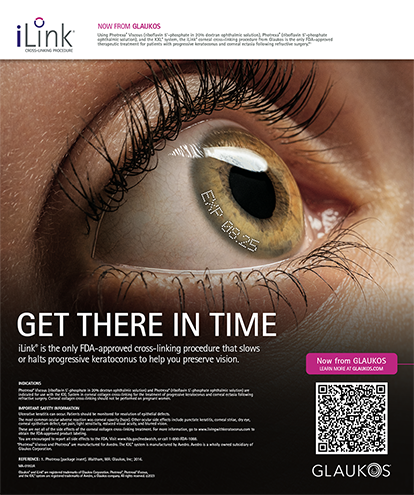
In some countries in Europe, ophthalmologists have been performing immediate sequential bilateral cataract surgery (ISBCS) for many years. Although it is not yet commonly performed in the United States, the practice is slowly gaining acceptance for certain patients. Like your European colleagues, a limited number of US surgeons perform ISBCS on a regular basis.
The advantages of this approach for patients include a faster return of binocular vision, no period of anisometropia, and the ability to more quickly resume daily activities that are affected by vision.1 As cataract surgery advances, so do patient expectations, and, as word spreads about this option, more patients may seek the benefits of ISBCS.
POTENTIAL COMPLICATIONS
However, concerns about complications that could potentially result in bilateral vision loss have, for many surgeons, outweighed the advantages of this approach. Surgeons are mostly concerned about bilateral endophthalmitis. Although endophthalmitis is a rare complication, it can result in significant vision loss even when treated appropriately. Another potential complication of concern is bilateral toxic anterior segment syndrome.
The risks of complications can be mitigated by instituting the strict protocols described in the ophthalmic literature, such as using intracameral antibiotics and disposable instruments and separately prepping and draping each eye.1
Cataract surgery continually becomes more technologically sophisticated, and outcomes are increasingly tailored to the individual patient. Patient-specific outcomes today include not only complete cataract removal with an IOL well centered in the capsular bag, but also a refractive outcome tailored to the patient’s needs. Some surgeons have found that, for many of their patients, the benefits of ISBCS outweigh the risks of rare complications. The procedure might be eligible for coverage under Medicare in certain situations (see A Sample LCD for ISBCS).
A Sample LCD for ISBCS
Medicare has recently covered immediate sequential bilateral cataract surgery (ISBCS) under certain conditions. This is a highly significant change. The following statement appears in a local coverage determination (LCD) for CGS Administrators, a Medicare Administrative Contractor (MAC) serving more than 24 million Medicare beneficiaries. This LCD, L33954 (Cataract Extraction), explains policy regarding bilateral same-day cataract surgery:
Bilateral cataract extraction performed on both eyes, on the same date of service, is termed immediate sequential bilateral cataract surgery (ISBCS). ISBCS as an approach to bilateral cataract extraction may afford certain clinical benefits, but carries with it the possibility of bilateral visual loss. The decision to perform ISBCS should be an individual decision, made jointly by the patient and physician. The medical record must document the rationale for ISBCS and that the patient has been apprised of the risks and benefits of both this approach and of the available alternatives.
Similar statements appear in LCDs for other MACs. This statement about the conditions for coverage is instructive when considering how to construct an informed consent tailored to ISBCS.
BASIC TENETS OF INFORMED CONSENT
Acquiring the patient’s informed consent is a well-established requirement for any medical intervention. For major procedures, it is a crucial element to ensure that informative patient communication takes place before surgery and to limit medical malpractice liability. In some cases, the informed consent must be more extensive to match the risks and complexities of a particular procedure and a patient’s condition. The basic concepts, requirements, and best practices for acquiring informed consent are listed in the accompanying graphic below.
The surgeon presents and discusses the following information (specific requirements vary according to state and country laws):
- Patient diagnosis;
- Nature of the proposed procedure;
- Alternatives and options;
- Risks and benefits of all the proposed and alternative treatments;
- Risks and benefits of not pursuing any form of treatment; and
- Surgeon responses to patient questions.
The surgeon communicates clearly and slowly, using terms that the patient understands. Communication can be facilitated by various media, including literature and instructional videos.
The surgeon confirms the patient’s capacity to understand all of the information discussed and the patient’s voluntary assent to the procedure in light of this understanding.
The surgeon documents that the above conversation happened and that the patient understood each and every aspect of the conversation.
INFORMED CONSENT CONSIDERATIONS FOR ISBCS
Undergoing ISBCS should be an individual patient’s decision made jointly with the surgeon. The medical record must document the rationale for choosing ISBCS and that the patient has been apprised of the risks and benefits of both this approach and of the available alternatives.
The patient’s preference for ISBCS should be documented along with the patient’s rationale for desiring surgery on both eyes on the same day. The patient must understand that he or she has the option to delay surgery on the second eye. Mere convenience alone may not be an appropriate rationale. A better rationale would be to describe how ISBCS will help the patient with his or her visual needs or help to avoid certain symptoms. Without a sufficient rationale, if there were a complication, the patient (or his or her attorney) could later claim that this rationale reflected a lack of understanding by the patient about the risks and benefits of this approach. It is important that the consent document clearly explains the risks and benefits of both the traditional approach of waiting several days or weeks between surgeries and ISBCS. The patient must understand that there is a low (but not zero) risk of significant bilateral visual loss from ISBCS.
CONCLUSION
It is important for surgeons interested in ISBCS to devote careful attention to crafting and using an informed consent process that fully informs the patient and allows optimal shared decision-making to achieve the best possible outcome.
1. Malvankar-Mehta MS, Chen YN, Patel S, et al. Immediate versus delayed sequential bilateral cataract surgery: a systematic review and meta-analysis. PLoS One. 2015;10(6):e0131857.




